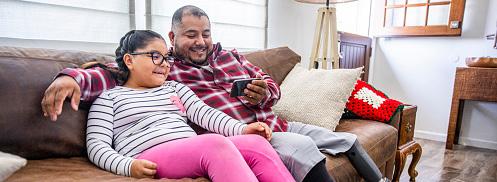NATIONAL DIABETES PREVENTION PROGRAM
AUDIENCE PROFILE

NATIONAL DIABETES PREVENTION PROGRAM
AUDIENCE PROFILE

To successfully engage your population of focus, it is important to have a clear understanding of their culture, beliefs, and barriers to health. This audience profile includes information about the cultural nuances to be considered when reaching persons with disabilities, also known as persons with diverse abilities, based on the review of various research studies—and taking into consideration lessons learned through past experiences working with this audience. This document is not an in-depth research report or analysis, as it is meant to provide a general understanding of various factors that may affect your audience’s availability, interest, and/or commitment to your National Diabetes Prevention Program (National DPP) lifestyle change program (LCP). Use the questions listed at the end of this profile to validate and expand on the information provided for your local program’s market.

The general definition of disability is any condition or impairment of the body or mind that makes it more difficult for a person with the condition to do certain activities and interact with the world around them. According to the World Health Organization, disabilities have three dimensions:
ο Impairment in a person’s body structure or function or in their mental functioning; examples of impairments include loss of a limb, loss of vision, or memory loss.
ο Activity limitation, such as difficulty seeing, hearing, walking, or problem solving.
ο Participation restrictions in normal daily activities, such as working, engaging in social and recreational activities, and obtaining health care and preventive services.
While noting that there is no single definition of disability, the U.S. Census Bureau’s American Community Survey (ACS) is a main source for collecting information on people with disabilities to better see trends over time. The ACS describes identification criteria used for six types of disability in all age groups: vision, hearing, cognitive, ambulatory, self-care, and independent living.
Ambulatory disability—having serious difficulty with movement including walking or climbing stairs.
Independent living disability—due to a physical, mental, or emotional problem, having difficulty doing errands alone such as visiting a doctor’s office or shopping.

Cognitive disability—due to a physical, mental, or emotional problem, having difficulty thinking, learning, remembering, concentrating, communicating, or making decisions.

Hearing disability—being deaf or having serious difficulty hearing.

Self-care disability—having difficulty bathing or dressing.
Visual disability—being blind or having serious difficulty seeing, even when wearing glasses.
Although “people with disabilities” is sometimes used to refer to a single population, this is actually a diverse group of people with a wide range of needs. Persons with disabilities include individuals of all ages, genders, races and ethnicities, geography, education, employment, and income levels. Two persons with the same type of disability can be affected in very different ways. Some disabilities may not be physically visible.

The percentage of persons with disabilities varies by state. It also depends on how disability levels— the degree to which a disability impacts a person’s life—affect employment, income, poverty, and health behaviors. According to the 2020 Disability Statistics Compendium, 41.2 million persons had a disability in 2019, which is 12.7 percent of the nation’s total population. California was the state with the highest number (4,131,700) of persons with disabilities; Wyoming had the smallest number (77,816) due to the state’s smaller population.
Among persons with disabilities, 38.4 percent have non-physically visible disabilities, such as a learning or cognitive disability, hearing loss, multiple sclerosis, or Crohn’s disease. In 2019, Delaware had the highest percentage (43.3 percent) and South Dakota had the lowest percentage (31.8 percent) of persons with disabilities in this category.

In 2018, the percentage of workingage civilian veterans with a U.S. Veterans Administration-determined service-connected disability was 27.9 percent
12.7% With Disabilities, 2019 U.S. Population
38.4% Non-Physically Visible, 2019 U.S. Population with Disabilities






27.9% Service-Connected Civilian Veterans, 2018 U.S. Veterans Administration

Employment is a key factor in the social integration and economic self-sufficiency of working-age persons (aged 21–64) with disabilities. According to 2021 data from the U.S. Bureau of Labor Statistics, 21.3 percent of working-age persons with a disability were employed compared to 65.4 percent of persons with no disability. Among workers with a disability, 30 percent were employed part-time compared with 16 percent for those with no disability. Employed persons with a disability were more likely to be self-employed than those with no disability.
Employment rates vary by the type of disability—they are highest for persons with hearing disabilities (53.6 percent) and vision disabilities (45.4 percent) and lowest for those with self-care disabilities (16.2 percent) and independent living disabilities (18.1 percent).
The unemployment rate for persons with a disability (7.6 percent), which was twice that of persons without a disability (3.5 percent), declined in 2022 from the previous year in both groups.
Employment and employability determine annual income for persons with and without disabilities. According to the Disability Status Report, in 2018 the median annual earnings of working-age individuals with disabilities who worked full-time/full-year was $40,500 compared with $49,200 among those without disabilities.
In 2019, 25.9 percent of adults with disabilities experienced poverty compared with 11.4 percent of the U.S. population without disabilities. The poverty rate for persons living with disabilities was highest in the District of Columbia (35.5 percent) and lowest in Delaware (18.3 percent).
Individuals with disabilities are more likely to rely on federal and state-funded health insurance programs, such as Medicare and Medicaid, compared with those without disabilities. In 2018, 19 percent of working-age people with disabilities received Supplemental Security Income payments.
In 2018, the education levels of working-age persons with disabilities in the United States were as follows:
ο 34.2 percent: no higher than a high school diploma or equivalent
ο 32.0 percent: some college or an associate degree
ο 15.2 percent: a bachelor’s degree or more
Federal regulations supporting persons with disabilities in the United States: AMERICANS WITH DISABILITIES ACT (1990)—A civil rights law that protects persons with disabilities from discrimination in most settings, including federal and local governments, schools, and employers.
INDIVIDUALS WITH DISABILITIES EDUCATION ACT (1975)—Supports special education and related services for children and youth with disabilities. This regulation includes eligibility requirements for establishing an Individualized Education Plan for students with disabilities.
THE REHABILITATION ACT (1973)—Prohibits discrimination on the basis of disability and applies to any program that receives federal financial support. This regulation includes Section 504, which requires schools to provide free appropriate public education to each qualified student.

The Americans with Disabilities Act prohibits discrimination against qualified individuals with disabilities, which includes persons with diabetes. This law applies to persons with diabetes in settings such as government services, public accommodations, schools, and the workplace—including occupational positions such as truckers, pilots, and military personnel.
Persons with diabetes are at higher risk for additional disabilities due to diabetes complications—such as blindness, amputation, heart disease, stroke, and kidney disease. In general, persons with diabetes report rates of disability that are higher than those reported by the overall population. This includes the types of disability described by ACS.
In 2018, about 1 in 6 persons with disabilities (16.7 percent) in the United States had been diagnosed with diabetes, compared with 1 in 14 persons without disabilities (7.4 percent).
Persons who have overweight (body mass index [BMI] of 25 or greater) or obesity (BMI of 30 or greater) are more likely to develop type 2 diabetes, high blood pressure, and high levels of blood fats—which are all risk factors for heart disease and stroke. In 2019, the obesity rate for U.S. adults with disabilities was 40 percent, compared with 28 percent for adults without disabilities. In 2019, 23.1 percent of adults with disabilities were smokers compared with 12.3 percent of adults without disabilities. Smoking increases a person’s risk for diabetes, cancer, heart disease, and stroke.
Most persons with disabilities report their health as good, very good, or excellent—particularly those in a supportive environment with available resources. However, the percentage of persons with disabilities who view their health in one of these three categories is smaller than the percentage of those without disabilities who report the same. Studies have shown that adults with disabilities are more likely than those without disabilities to report physical inactivity, poorer overall health, less access to quality health care, and feelings of isolation. Persons with disabilities often are at greater risk for secondary health conditions—including chronic pain, depression, and chronic illnesses.
1 in 6 persons with disabilities in the United States diagnosed with diabetes in 2018.
Each person with a disability is unique and may identify with one or more disability categories. A person who experiences a visual disability at age 40 may not have the same life experience and perspective as a person who was born without vision. It is important to hear and validate each person’s journey, as the individual relates to their disability in a unique way. People with learning disabilities or mental health and emotional conditions may feel differently about their disability status than those living with a physical disability. Some persons may feel more connected to or prioritize their identity related to gender, ethnicity, or age—over their identity of having a disability.
For a person with a disability, his or her identity impacts relationships as a family member, friend, colleague, member of an organization, customer, or employee. The way a person experiences the world and is treated by others in their home, school, and community may lead to conflicting internal and external identities. For example—internally, a person may know they have a disability and “own” it—while externally, the person may choose not to disclose or outwardly show their disability with co-workers, family, and others.

Organizations that aim to learn and understand the needs of persons with disabilities—and are inclusive in messaging, images, and actions and authentic in their approach to diabetes prevention—may be more effective in engaging persons with disabilities and their networks. This can be most challenging when a person chooses not to identify with or reveal their disability, and a tactful approach by the organization may be helpful.

Internally, a person may know they have a disability and “own” it—while externally, the person may choose not to disclose or outwardly show their disability with co-workers, family, and others.
Over the last few decades, many persons with disabilities have moved from a historically marginalized and isolated audience to being more engaged through education, employment, health access, and advocacy. The Americans with Disabilities Act of 1990 greatly improved access, as the law prohibits discrimination on the basis of disability in employment, state and local government programs, public accommodations, health care, transportation, and communication. The law also sets minimum standards for accessibility of the built environment for all persons.
Engagement, independence, health, social relationships, and full participation of persons with disabilities is greatly influenced by how they are viewed by the world around them. In addition to having to adapt to and navigate physical barriers and their surroundings at every turn, persons with disabilities typically deal on a daily basis with stigma, bias, and exclusion among people in society as a whole. Persons with disabilities may feel a lack of community support and that they are not valued.
Including people with disabilities in everyday activities and encouraging them to have roles similar to their peers who do not have a disability is called disability inclusion . Disability inclusion means understanding the relationship between the way persons function and how they participate in society and making sure everyone has the same opportunities to participate in every aspect of life to the best of their abilities and desires.

Engagement, independence, health, social relationships, and full participation of persons with disabilities is greatly influenced by how they are viewed by the world around them.











Community partnerships are critical to address inclusion of persons with disabilities in the National DPP LCP and public health needs. Expertise is not necessary to successfully engage with persons with disabilities. There are organizations at the national, state, and local level that can offer technical assistance to help build inclusion assets and recruit participants into the National DPP LCP. Keep in mind the following to help identify and engage key disability organizations: State and local government agencies can guide programs to resources and services that participants might need. For example, the state department of services for the deaf or a Mayor’s Council for People with Disabilities may have resources that offer American Sign Language interpretation.
Disability service organizations can serve as both a recruitment partner and a source of technical assistance. These organizations can be condition-specific, such as a Muscular Dystrophy Association chapter, or they can be crossdisability, like Easter Seals, Special Olympics chapters, or Centers for Independent Living.
Community-based organizations often have personnel who are well-versed in disability inclusion or general program adaptation. Examples include Allied Health personnel at a local hospital, rehab center, or parks and recreation department.
Schools may not seem like an immediate choice, but they have personnel with experience in adapting physical or special education to accommodate student needs. Leveraging their expertise may be beneficial.


Inclusion barriers. By building relationships and partnering with disability organizations and advocates, LCP programs can increase their capacity for inclusion, which in turn may help to increase participation among persons with disabilities. Disability partners can help programs to be proactively mindful of inclusion and offer options for persons with disabilities to participate in a program from the outset; for example, ensuring ramp access near the room where the program is held.
Medical barriers. Many persons with disabilities must adhere to individualized medical regimens that include diet, exercise, therapies, and medication. Introducing an LCP that includes new approaches to healthy lifestyles may conflict with an individual’s medical therapies already in place; programs can work with participants and their health care providers to minimize these barriers.
Accessibility and accommodations. Individuals with disabilities often require accommodations to ensure inclusion and their full program participation. Programs and coaches are trained to interview new participants and assess their individual needs, in a tactful and respectful manner, to ensure inclusivity and accessibility. This may include developing or providing accessible websites, sign language interpreters, assistive technologies, written instructions, larger print materials, elevators or first-floor meeting spaces, and weight scales that accommodate wheelchairs, among others.
Some physical barriers that can limit and impede access include stairs at the entrance to a building; services located on floors without access to an elevator; inaccessible doorways and rooms that do not accommodate a wheelchair; inaccessible rest rooms without space for wheelchair access or assistive rails; buildings and rooms with poor acoustics or lack of assistive hearing devices; health services located far from where most persons live; and health facilities that are poorly lit with no clear signage, making it confusing and difficult for persons with disabilities to find their way around.
Barriers to Learning. A recommended resource for LCPs is Prevent T2 for All, which is an adaptation of Prevent T2 , the National DPP lifestyle change program. The adaptations focus on accommodating persons who have vision, hearing, cognitive, ambulatory, self-care, and independent living disabilities. This inclusive program is designed to promote modest weight loss, increased physical activity, and other lifestyle changes for adults diagnosed with prediabetes.
Family and friends, many who serve as caregivers and support professionals, are reliable and trusted sources of health information for persons with disabilities. Persons with disabilities and their families represent a large network of consumers and advocates whose focus may extend beyond disabilities when networking and seeking health information.
Organizations that represent and advocate for individuals with disabilities are key sources of health information and referrals to health care programs and services. Local diabetes prevention program efforts that are endorsed by or co-presented with disability partners can provide authenticity and expertise in inclusion.
The medical community and health care providers, particularly those involved in long-term care and support for individuals with disabilities, may be influential in offering a variety of health and diabetes prevention information and resources.

Persons with disabilities need public health programs and health care services for the same reasons anyone does—to be healthy, active, and engaged as part of the community. Disability inclusion involves gathering input from persons with disabilities and providing them with tools and information to make healthy choices and learn ways to prevent illness. Persons with disabilities are best served by public health when they are included in all programs and activities, such as:
ο Education and counseling programs that promote physical activity, improve nutrition, or reduce the use of tobacco, alcohol, or drugs.
ο Blood pressure and cholesterol assessment during annual health exams, and screening for illnesses such as cancer, diabetes, and heart disease.
Suggested health promotion strategies for National DPP LCPs are listed below.
ο Engage family, caregivers, and others who are important influencers for persons with disabilities. Caregivers can act as conduits of information related to diabetes prevention. However, take care not to exclude the person with a disability by “othering” or “talking around them” when engaging a caregiver or family member.
ο Partner with trusted community organizations that have a strong reputation advocating for persons with disabilities—and can serve as program recruiters, organizers, promoters, and leaders.
ο Engage health care providers to help promote and recruit for the program. Individuals with disabilities often rely on their health care teams for long-term care; these teams may include rehabilitation professionals, physical therapists, nutritionists, and primary and specialty care providers.
ο Ensure accessibility and provide accommodations for participants. To provide accessible environments, make sure you have any needed assistive technologies and communicate information effectively to all parties involved. Consider partnering with disability organizations for support to ensure inclusion.
ο Provide specially trained lifestyle coaches to guide participants through the program and provide individualized follow-up. To ensure that persons with all disabilities feel welcomed and can fully participate and succeed in the program, lifestyle coaches should prepare to address a range of environmental, physical, programmatic, and emotional barriers and challenges with specially developed materials and learning methodologies. Examples include addressing learning disabilities such as dyslexia, as well as color blindness, which can also affect learning, with specially developed materials and learning methodologies.
ο To support the implementation of your program within the community and fully address the needs of persons with disabilities, consider these strategies for communicating effectively both with and on behalf of persons with disabilities.
Person who uses a wheelchair
Emphasize abilities, not limitations
Do not use language that suggests a lack of something
Emphasize the need for accessibility, not the disability
Do not use offensive language
Avoid language that implies negative stereotypes
Do not portray people with disabilities as inspirational only because of their disability
Confined or restricted to a wheelchair, wheelchair bound
Person who uses a device to speak Can’t talk, mute
Person with a disability
Person of short stature
Person with cerebral palsy
Person with epilepsy or seizure disorder
Person with multiple sclerosis
Accessible parking or bathroom
Person with a physical disability
Person with an intellectual, cognitive, developmental disability
Person with an emotional or behavioral disability, a mental health impairment, or a psychiatric disability
Person without a disability
Person who is successful, productive
Disabled, handicapped
Midget
Cerebral palsy victim
Epileptic
Afflicted by multiple sclerosis
Handicapped parking or bathroom
Crippled, lame, deformed, invalid, spastic
Slow, simple, moronic, defective, afflicted, special person
Insane, crazy, psycho, maniac, nuts
Normal person, healthy person
Has overcome his/her disability, is courageous
ο The National DPP LCP can be empowering and offers participants an opportunity to be in charge of their health. For some persons with disabilities, this is a welcome experience and may foster a feeling of independence.

ο A proven program with a lifestyle coach offers participants a go-to source for accurate information and tested practices that work.
ο With an organized and structured program, you are able to engage and guide persons with disabilities to lead a healthy lifestyle and reduce their risk of type 2 diabetes.
ο The program provides an in-person or virtual group setting—along with tailored content—that allows participants to receive community support while facing their own challenges on the road to a healthy lifestyle to prevent type 2 diabetes. The group setting provides an environment for sharing different ideas and perspectives with other participants, including motivation for individual success.
Communication platforms, such as those used by online bloggers and social influencers, often provide health information across disability communities and channels. Word-of-mouth communication through testimonials may offer a great opportunity for LCP promotion, as persons with disabilities may be more likely to trust individuals who describe their similar challenges and experiences. Whether a person receives accurate health information may also be driven by social determinants of health, including access to health care and information and health insurance coverage.
The internet is a valuable health information resource for many persons with disabilities who may experience transportation barriers to visiting their health care provider (e.g., physician’s office or clinic). These individuals may more readily search online for health information and medical treatments. Persons with disabilities may also be more likely to initiate online communication with health care providers and educators to learn about enhancing their health through lifestyle changes, such as nutrition and physical activity. It is recommended that programs refer persons with disabilities to credible health organizations, as well as the Centers for Disease Control and Prevention or other government sites, for medical information.
Technology provides opportunities for persons with disabilities to engage with media, networks, and social media—allowing individuals to participate in online communities to share their experiences and discuss challenges, approaches, and health strategies. While technology use has increased among certain groups, it is important to consider that there is still a digital divide for persons with a range of disabilities, from visual or hearing loss to physical or intellectual disabilities. Examples of barriers and challenges in accessing health care and information include:
ο Videos provided online without captioning.
ο Live webinars provided without ASL interpreters.
ο Persons who experience difficulty holding a computer mouse and need alternatives for computer and internet navigation.

When developing messages for people with disabilities, consider the following:
ο Use respectful and inclusive language that recognizes the individual as a person, just like everyone else. This means using person-first terminology and leading with the individual rather than the disability, as in saying “a person with a disability” or “participants with disabilities” instead of “a disabled person.” Avoid using terminology with negative connotations such as “confined to a wheelchair,” “handicapped,” “physically challenged,” or “the disabled.”
ο Engage disability organizations as partners to understand the most respectful and effective ways in which they communicate with persons with disabilities.
ο Use culturally relevant person-first messages, graphics, and images—in terms of language and ethnicity—that are relatable to each person’s lived experience.
ο Include images of an individual or individuals with disabilities in your messaging and written materials that will resonate with persons with disabilities in your community.
ο Ensure that messages and graphics are accessible to persons with blindness or low vision.


ο To ensure that persons with disabilities can access and understand your resources, provide clear messages and alternative/descriptive text as well as appropriate graphics, colors, fonts, and formatting. Online communications must meet guidance for Section 508 of the Rehabilitation Act of 1973, which ensures that information and communication technology is accessible and usable for individuals with disabilities.
ο If using widgets to share health information electronically—such as buttons, dialog boxes, or drop-down menus—ensure that individuals with disabilities are receiving relevant information on their devices.
For additional information about working with persons with disabilities, please visit the resources highlighted below:
GENERAL HEALTH
Administration on Disabilities, Administration for Community Living
Disability Impacts All of Us, CDC
National Programs on Health Promotion for People with Disabilities, CDC
Disability and Health Overview, CDC

Disability and Diabetes, CDC

Disability and Health Data System, CDC Communicating With and About People With Disabilities, CDC
Building Healthy Inclusive Communities, National Center on Health, Physical Activity and Disability (NCHPAD)



Disability and Diabetes Prevention, CDC Prevent T2 for All, NCHPAD

Recruiting People with Disabilities, NCHPAD (YouTube)
Exercising With Diabetes and Secondary Conditions, NCHPAD
o What is the demographic background of persons with disabilities in your community? (e.g., population percentage, age, country of origin and birth, language, socioeconomic status, immigrant, and refugee status).
o What is the level of food insecurity among this population?
o What percentage of persons with disabilities in your community has diabetes or prediabetes?
o What are the cultural backgrounds and language differences among persons with disabilities in your community?
o Within your community, are there groups that work with audience members such as coalitions, mutual aid societies, chambers of commerce, community, or faith-based organizations?
o Where specifically do persons with disabilities go for health care services?
o How accessible is health care for persons with disabilities within the community?
o Who are the trusted sources for health information among persons with disabilities in the community? Are health sources different or the same as other trusted sources?
o Who are the trusted thought leaders (e.g., community influencers, disability organizations)—specific to persons with disabilities in the community or in general?
» Community-based organizations? Faith communities? Health care providers? Vocal advocates?
o Who are the leaders and champions or gatekeepers for persons with disabilities in the community? With whom do you need to collaborate?
o How can you use these trusted sources to help you market and promote your lifestyle change program among persons with disabilities in the community?
o Which media channels—including social and digital media—are most popular or preferred among persons with disabilities in the community?
o What relationships do you have with these media outlets? Who do you need to reach out to?
o What infrastructure does your organization have to use popular social and digital channels? What media channels do you need to strengthen?
o Are your messages delivered in accessible formats? Are messages and graphics accessible to persons with blindness or low vision?
o Are your messages respectful and inclusive and do they recognize the individual as a person? This means using person-first terminology and leading with the individual rather than the disability.
o Are the language(s) and literacy level appropriate for the persons with disabilities you are trying to reach?
o Do you use culturally relevant messages, graphics, and images—in terms of language and ethnicity—that are relatable to each person’s lived experience?
o Are you engaging disability organizations as partners to understand the most respectful and effective ways in which they communicate with persons with disabilities?
o What are the specific barriers to promoting the lifestyle change program with persons with disabilities in your community?
o How will you work to mitigate these barriers and with whom?
o What lifestyle change program benefits are meaningful to persons with disabilities in your community? How can you work these benefits into your marketing materials?
o What does your lifestyle change program offer persons with disabilities in your community that other disease prevention programs or events do not—or cannot—offer?
1. Volupta ectoribeat odiae maion eiur? Verspis exceperit, eos suntiae molum erum il il inctus il magnationsed et, occum et illorero officit od que dolor accumque pro bernat volupient.
2. Ad quamus aut exceati orroviducium sus dolupta tiuntust fugiam faceper ehende ne et, totae. Et ut quo et excestiis veliquosa quibeaqui antur?
3. Sequi vellant vitem ilitesequis dolut iuntibu sdanda earchiciam faccum dollenia sediti omnis ut que occab in exerias eatiam, eruntiatur moluptiunt, quibus miliquo
4. Verchicipsum et es sam, que seque evelibus unt aborrov itatius, eaturitius eum fugiam, aut la nonecta tianim expeditisite vollatia conestiur as et fugiam fuga.
5. In nessin cone cor aut exernat ioreribus que prehentem fugias inctaessedis re nates miniscidel est, inctem eum harum eium qui aut pre qui consed
6. Molupta turerit ationsequam hil ea nulparum lab ipsam aut vent fuga. Tur, quae commoloreium volupid eost audae modia audia quodi blanditatur?
7. Imossi dis que modions enihicae quaspis eum que sunt fugit, sequiam audi verovitate nobis modignam iume volest occusdamus, ius de mos veliten dernatus, omnihil
8. Loriatiorro veles id molo molut is es ducidel lautem vel ipsam quae opta nostis ra earundem quassi optat fugias eossi nimetur, offictur, aliaest, comnis volorer roviducia
9. Volupta eceptatatet reptatem ipsae. Nam, que cone non prae cum quae quae dolores dit, nonse voluptate volorum et
